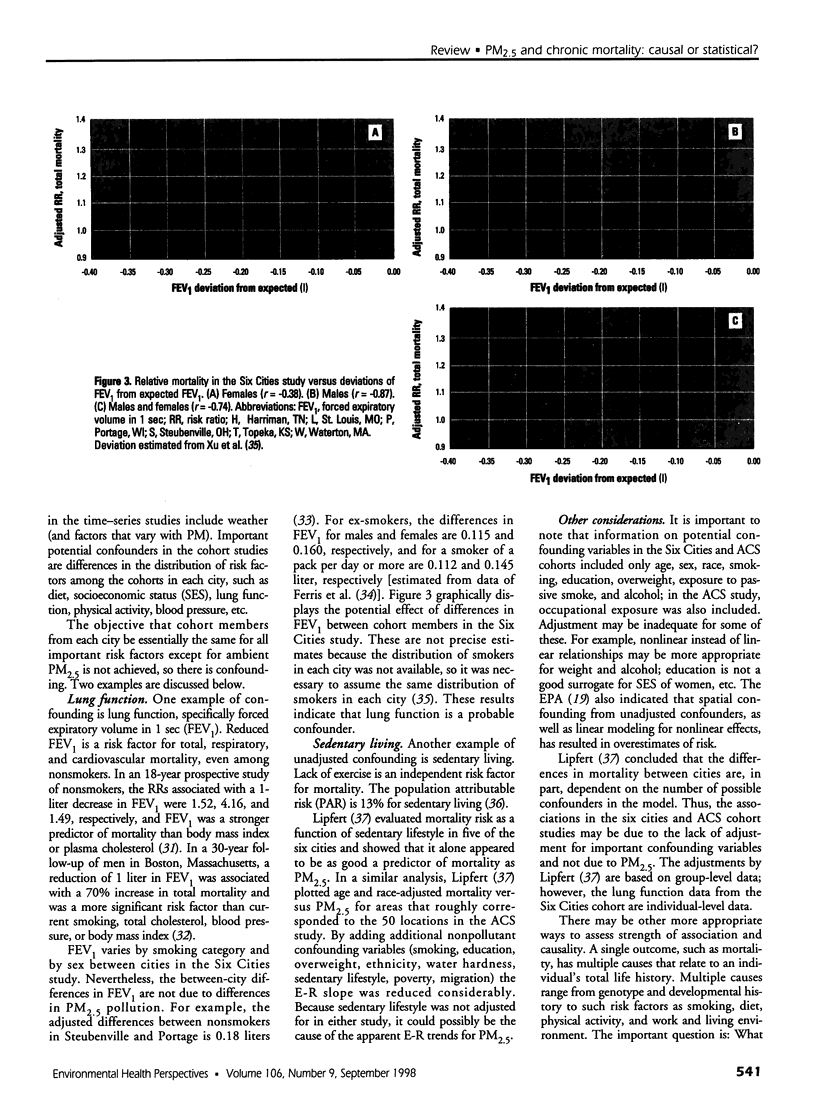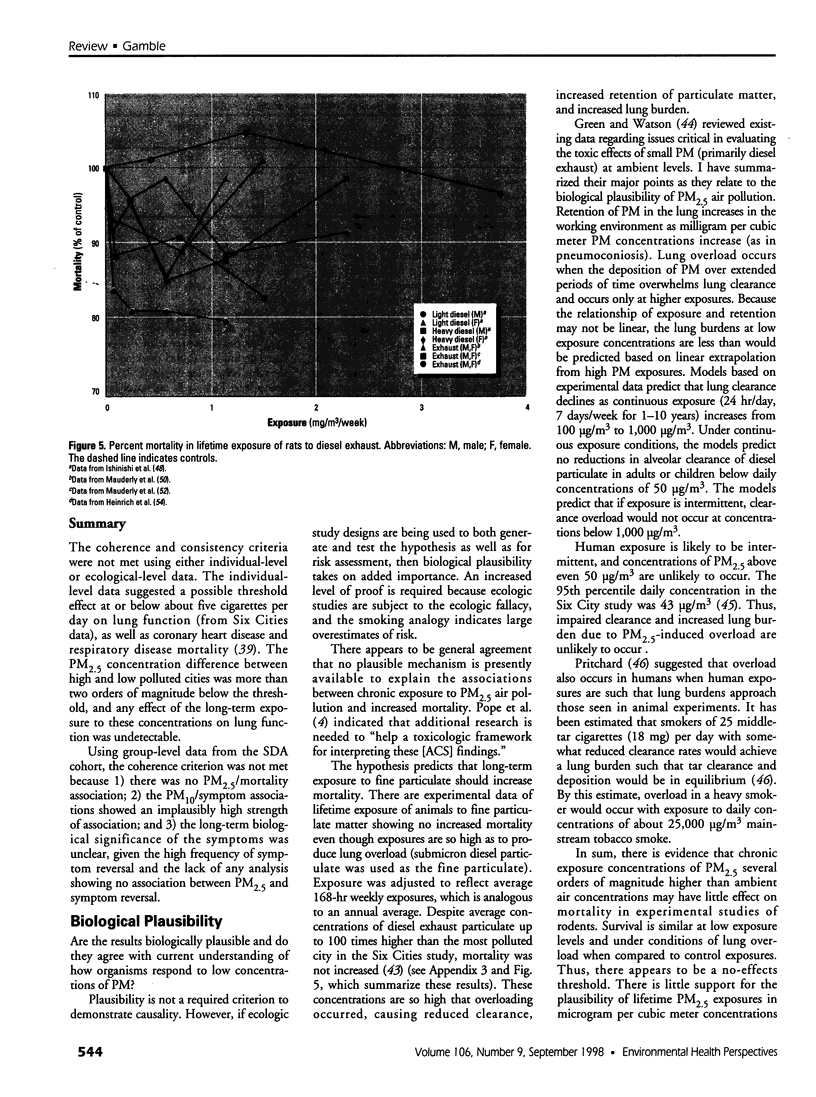Abstract
Concentrations of ambient PM2.5 (particulate matter <2.5 microm in aerodynamic diameter) were associated with increased mortality in two prospective cohort studies. In this paper, I assess whether the weight of the evidence supports a causal association. I assumed the study population in each city to have the same exposure; therefore, these are ecologic studies because exposure is at the group level. Health outcome and confounding data are at the individual level. Ambient PM concentrations are inadequate surrogates for personal exposure because they are at the group level and comprise only a small proportion of personal exposure, they change over time, and they constitute only a small proportion of a life span. The strength of association and exposure-response relationships cannot be determined because the ecologic group-level risks of PM2.5 are overestimated 150- to 300-fold based on an analogy with individual-level exposure to inhaled cigarette smoke. Risk estimates may also be high because of confounding from factors such as physical activity and lung function. The evidence is not coherent because the stronger associations are expected to be with morbidity, but instead are with mortality. For example, PM2.5 was associated with mortality but not with measurable reductions in lung function. Biological plausibility is lacking because lifetime exposure of rats to combustion products at concentrations two to three orders of magnitude higher than air pollution levels cause lung overloading but no consistent reduction in survival. Criteria for quantitative risk assessment are not met so the data are not useful for setting air quality standards. The weight of evidence suggests there is no substantive basis for concluding that a cause-effect relationship exists between long-term ambient PM2.5 and increased mortality.
Full text
PDF














Images in this article
Selected References
These references are in PubMed. This may not be the complete list of references from this article.
- Abbey D. E., Hwang B. L., Burchette R. J., Vancuren T., Mills P. K. Estimated long-term ambient concentrations of PM10 and development of respiratory symptoms in a nonsmoking population. Arch Environ Health. 1995 Mar-Apr;50(2):139–152. doi: 10.1080/00039896.1995.9940891. [DOI] [PubMed] [Google Scholar]
- Bates D. V. Health indices of the adverse effects of air pollution: the question of coherence. Environ Res. 1992 Dec;59(2):336–349. doi: 10.1016/s0013-9351(05)80040-4. [DOI] [PubMed] [Google Scholar]
- Brenner H., Savitz D. A., Jöckel K. H., Greenland S. Effects of nondifferential exposure misclassification in ecologic studies. Am J Epidemiol. 1992 Jan 1;135(1):85–95. doi: 10.1093/oxfordjournals.aje.a116205. [DOI] [PubMed] [Google Scholar]
- Dockery D. W., Pope C. A., 3rd, Xu X., Spengler J. D., Ware J. H., Fay M. E., Ferris B. G., Jr, Speizer F. E. An association between air pollution and mortality in six U.S. cities. N Engl J Med. 1993 Dec 9;329(24):1753–1759. doi: 10.1056/NEJM199312093292401. [DOI] [PubMed] [Google Scholar]
- Dockery D. W., Speizer F. E., Ferris B. G., Jr, Ware J. H., Louis T. A., Spiro A., 3rd Cumulative and reversible effects of lifetime smoking on simple tests of lung function in adults. Am Rev Respir Dis. 1988 Feb;137(2):286–292. doi: 10.1164/ajrccm/137.2.286. [DOI] [PubMed] [Google Scholar]
- Dockery D. W., Speizer F. E., Stram D. O., Ware J. H., Spengler J. D., Ferris B. G., Jr Effects of inhalable particles on respiratory health of children. Am Rev Respir Dis. 1989 Mar;139(3):587–594. doi: 10.1164/ajrccm/139.3.587. [DOI] [PubMed] [Google Scholar]
- Dockery D. W., Ware J. H., Ferris B. G., Jr, Glicksberg D. S., Fay M. E., Spiro A., 3rd, Speizer F. E. Distribution of forced expiratory volume in one second and forced vital capacity in healthy, white, adult never-smokers in six U.S. cities. Am Rev Respir Dis. 1985 Apr;131(4):511–520. doi: 10.1164/arrd.1985.131.4.511. [DOI] [PubMed] [Google Scholar]
- Ferris B. G., Jr, Speizer F. E., Spengler J. D., Dockery D., Bishop Y. M., Wolfson M., Humble C. Effects of sulfur oxides and respirable particles on human health. Methodology and demography of populations in study. Am Rev Respir Dis. 1979 Oct;120(4):767–779. doi: 10.1164/arrd.1979.120.4.767. [DOI] [PubMed] [Google Scholar]
- Gori G. B., Mantel N. Mainstream and environmental tobacco smoke. Regul Toxicol Pharmacol. 1991 Aug;14(1):88–105. doi: 10.1016/0273-2300(91)90054-y. [DOI] [PubMed] [Google Scholar]
- Greenland S. Divergent biases in ecologic and individual-level studies. Stat Med. 1992 Jun 30;11(9):1209–1223. doi: 10.1002/sim.4780110907. [DOI] [PubMed] [Google Scholar]
- Greenland S., Robins J. Invited commentary: ecologic studies--biases, misconceptions, and counterexamples. Am J Epidemiol. 1994 Apr 15;139(8):747–760. doi: 10.1093/oxfordjournals.aje.a117069. [DOI] [PubMed] [Google Scholar]
- HILL A. B. THE ENVIRONMENT AND DISEASE: ASSOCIATION OR CAUSATION? Proc R Soc Med. 1965 May;58:295–300. [PMC free article] [PubMed] [Google Scholar]
- Heinrich U., Muhle H., Takenaka S., Ernst H., Fuhst R., Mohr U., Pott F., Stöber W. Chronic effects on the respiratory tract of hamsters, mice and rats after long-term inhalation of high concentrations of filtered and unfiltered diesel engine emissions. J Appl Toxicol. 1986 Dec;6(6):383–395. doi: 10.1002/jat.2550060602. [DOI] [PubMed] [Google Scholar]
- Hertz-Picciotto I. Epidemiology and quantitative risk assessment: a bridge from science to policy. Am J Public Health. 1995 Apr;85(4):484–491. doi: 10.2105/ajph.85.4.484. [DOI] [PMC free article] [PubMed] [Google Scholar]
- Hinds W. C. Size characteristics of cigarette smoke. Am Ind Hyg Assoc J. 1978 Jan;39(1):48–54. doi: 10.1080/0002889778507712. [DOI] [PubMed] [Google Scholar]
- Karagianes M. T., Palmer R. F., Busch R. H. Effects of inhaled diesel emissions and coal dust in rats. Am Ind Hyg Assoc J. 1981 May;42(5):382–391. doi: 10.1080/15298668191419910. [DOI] [PubMed] [Google Scholar]
- Mauderly J. L., Banas D. A., Griffith W. C., Hahn F. F., Henderson R. F., McClellan R. O. Diesel exhaust is not a pulmonary carcinogen in CD-1 mice exposed under conditions carcinogenic to F344 rats. Fundam Appl Toxicol. 1996 Apr;30(2):233–242. doi: 10.1006/faat.1996.0061. [DOI] [PubMed] [Google Scholar]
- Mauderly J. L., Bice D. E., Cheng Y. S., Gillett N. A., Griffith W. C., Henderson R. F., Pickrell J. A., Wolff R. K. Influence of preexisting pulmonary emphysema on susceptibility of rats to inhaled diesel exhaust. Am Rev Respir Dis. 1990 May;141(5 Pt 1):1333–1341. doi: 10.1164/ajrccm/141.5_Pt_1.1333. [DOI] [PubMed] [Google Scholar]
- Mauderly J. L., Jones R. K., Griffith W. C., Henderson R. F., McClellan R. O. Diesel exhaust is a pulmonary carcinogen in rats exposed chronically by inhalation. Fundam Appl Toxicol. 1987 Aug;9(2):208–221. doi: 10.1016/0272-0590(87)90044-3. [DOI] [PubMed] [Google Scholar]
- Mauderly J. L., Jones R. K., McClellan R. O., Henderson R. F., Griffith W. C. Carcinogenicity of diesel exhaust inhaled chronically by rats. Dev Toxicol Environ Sci. 1986;13:397–409. [PubMed] [Google Scholar]
- Nikula K. J., Snipes M. B., Barr E. B., Griffith W. C., Henderson R. F., Mauderly J. L. Comparative pulmonary toxicities and carcinogenicities of chronically inhaled diesel exhaust and carbon black in F344 rats. Fundam Appl Toxicol. 1995 Apr;25(1):80–94. doi: 10.1093/toxsci/25.1.80. [DOI] [PMC free article] [PubMed] [Google Scholar]
- Paffenbarger R. S., Jr, Hyde R. T., Wing A. L., Lee I. M., Jung D. L., Kampert J. B. The association of changes in physical-activity level and other lifestyle characteristics with mortality among men. N Engl J Med. 1993 Feb 25;328(8):538–545. doi: 10.1056/NEJM199302253280804. [DOI] [PubMed] [Google Scholar]
- Piantadosi S., Byar D. P., Green S. B. The ecological fallacy. Am J Epidemiol. 1988 May;127(5):893–904. doi: 10.1093/oxfordjournals.aje.a114892. [DOI] [PubMed] [Google Scholar]
- Piantadosi S. Invited commentary: ecologic biases. Am J Epidemiol. 1994 Apr 15;139(8):761–771. doi: 10.1093/oxfordjournals.aje.a117070. [DOI] [PubMed] [Google Scholar]
- Pope C. A., 3rd, Thun M. J., Namboodiri M. M., Dockery D. W., Evans J. S., Speizer F. E., Heath C. W., Jr Particulate air pollution as a predictor of mortality in a prospective study of U.S. adults. Am J Respir Crit Care Med. 1995 Mar;151(3 Pt 1):669–674. doi: 10.1164/ajrccm/151.3_Pt_1.669. [DOI] [PubMed] [Google Scholar]
- Pritchard J. N. Dust overloading causes impairment of pulmonary clearance: evidence from rats and humans. Exp Pathol. 1989;37(1-4):39–42. doi: 10.1016/s0232-1513(89)80009-x. [DOI] [PubMed] [Google Scholar]
- Schwartz J., Dockery D. W., Neas L. M. Is daily mortality associated specifically with fine particles? J Air Waste Manag Assoc. 1996 Oct;46(10):927–939. [PubMed] [Google Scholar]
- Strachan D. P. Ventilatory function, height, and mortality among lifelong non-smokers. J Epidemiol Community Health. 1992 Feb;46(1):66–70. doi: 10.1136/jech.46.1.66. [DOI] [PMC free article] [PubMed] [Google Scholar]
- Taubes G. Epidemiology faces its limits. Science. 1995 Jul 14;269(5221):164–169. doi: 10.1126/science.7618077. [DOI] [PubMed] [Google Scholar]
- Ware J. H., Ferris B. G., Jr, Dockery D. W., Spengler J. D., Stram D. O., Speizer F. E. Effects of ambient sulfur oxides and suspended particles on respiratory health of preadolescent children. Am Rev Respir Dis. 1986 May;133(5):834–842. [PubMed] [Google Scholar]
- Weiss S. T., Segal M. R., Sparrow D., Wager C. Relation of FEV1 and peripheral blood leukocyte count to total mortality. The Normative Aging Study. Am J Epidemiol. 1995 Sep 1;142(5):493–503. doi: 10.1093/oxfordjournals.aje.a117665. [DOI] [PubMed] [Google Scholar]
- Xu X., Dockery D. W., Ware J. H., Speizer F. E., Ferris B. G., Jr Effects of cigarette smoking on rate of loss of pulmonary function in adults: a longitudinal assessment. Am Rev Respir Dis. 1992 Nov;146(5 Pt 1):1345–1348. doi: 10.1164/ajrccm/146.5_Pt_1.1345. [DOI] [PubMed] [Google Scholar]







